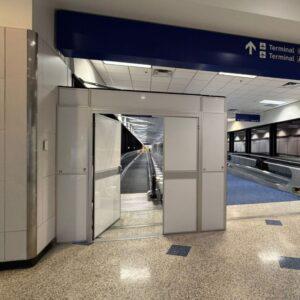The Role of Temporary Walls in Effective Airport Crowd Control
Managing large crowds in airports is a constant challenge. With millions of passengers traveling through these facilities daily, airports must balance efficiency, safety, and the overall customer experience. Effective crowd control is not just about security; it is key to ensuring that every aspect of airport operations flows smoothly—from check-in to baggage claim.
But what happens when airports face unexpected changes, busy seasonal peaks, or long-term renovation projects? This is where temporary wall systems step in as an adaptable and practical solution. Designed to guide passenger flow, ensure security, and support ongoing operations during changes, temporary walls offer a dynamic way to manage the complexity of airport spaces.
This guide explores the importance of airport crowd control, how temporary walls can make a difference, and why these systems are a smart choice for airport facilities.


Why Airport Crowd Control is Essential
Crowd control in airports is more than a logistical goal—it’s a necessity for safety, efficiency, and maintaining a pleasant travel experience. Without effective systems in place, congestion can overwhelm facilities, disrupt passenger movement, and compromise airport security standards.
Here are the three key reasons why crowd control is critical in airports:
- Security and Safety
Airports are high-security environments that require strict access control to restricted areas. Unchecked crowding in front of security screening lines or gates can lead to confusion, errors, or security lapses. Crowd control strategies, including temporary barriers, ensure passengers are organized, making it easier to carry out security procedures while reducing risks.
- Minimizing Congestion
From check-in counters to boarding areas and baggage claim zones, airports are designed for large volumes of people. However, when passenger flow isn’t managed adequately, bottlenecks occur. Overcrowding not only delays individual travelers but also disrupts broader airport operations, creating challenges for airlines and ground staff.
- Renovations and Adjustments
Airports are constantly evolving—renovations, expansions, and operational changes are part of their lifecycle. These projects, while necessary, often disrupt normal pathways and workflows. Temporary crowd control measures help maintain operations by ensuring passengers can safely and easily move through the airport, even during construction or sudden adjustments such as emergency closures.
How Temporary Walls Improve Airport Crowd Control
Temporary wall systems are a versatile solution for managing airport crowds in both everyday operations and during periods of change. Here’s how they make airport crowd control more effective:
- Guiding Passenger Flow
- Temporary walls create designated walkways, making it easier to direct passengers through specific routes.
- Clear, visually appealing barriers can prevent confusion, ensuring travelers know exactly where to go.
- By organizing movement, these systems reduce unnecessary wandering and keep high-traffic areas more manageable.
For example, temporary walls can guide passengers through redirected pathways during renovations, ensuring everyone moves safely and efficiently to the correct check-in counters or boarding gates.
- Managing Queues Efficiently
- Temporary barriers are perfect for organizing lines at security checkpoints, customs, and boarding gates.
- Strategically placed walls prevent overcrowding and allow staff to organize passengers into manageable groups, thus reducing wait times.
This helps turn an otherwise chaotic queuing system into an orderly process, improving both security accuracy and passenger satisfaction.
- Enhancing Security Measures
- Temporary walls restrict access to off-limits areas, ensuring only authorized personnel can enter.
- They provide privacy and added security for emergency situations or handling high-profile passengers.
For example, they can be used to discreetly shield emergency response teams from public view or to offer privacy for VIP travelers waiting for their flights.
- Supporting Construction and Renovations
Modern airports are rarely static—they are constantly upgrading. However, travelers still expect convenience, comfort, and cleanliness. During construction projects, temporary walls help by:
- Physically separating passengers from construction zones, safeguarding them from potential hazards.
- Reducing noise, dust, and visual clutter, which are common byproducts of construction activities.
These barriers allow airports to maintain a professional, efficient atmosphere while continuing to upgrade facilities for future travelers.
Key Benefits of Using Temporary Walls for Airport Crowd Control
Temporary wall systems provide numerous advantages beyond just managing crowds. Here’s what makes them such an effective tool in airport settings:
Flexibility
Temporary walls can be easily moved or reconfigured to adapt to changing traffic patterns or unexpected operational needs. This flexibility ensures they always meet the dynamic requirements of airport environments.
Cost-Effective
Using temporary solutions is significantly more affordable than installing permanent barriers, especially for short-term projects like renovations or seasonal adjustments.
Quick Deployment
Temporary barriers can be installed at short notice, making them invaluable for emergency situations. Whether it’s re-routing passengers due to flight cancellations or adjusting pathways for unforeseen delays, these systems are designed for rapid deployment.
Full-Service Solutions
When you choose modular wall systems from providers like Temporary Wall Systems, you benefit from a turn-key service that handles everything—delivery, installation, and eventual removal. This ease of implementation makes the process smooth and stress-free for facility managers.
Enhance Safety and Efficiency with Temporary Walls
Airports face unique challenges, from managing increasing passenger volumes to maintaining operations during significant construction projects. Temporary walls offer a straightforward, reliable solution for guiding passenger flow, securing sensitive areas, and safeguarding the passenger experience even in the face of disruption.
Whether you are managing a busy terminal renovation or preparing for the holiday rush, the flexibility, cost-effectiveness, and ease-of-use of temporary wall systems make them indispensable for modern airports. They don’t just improve airport crowd control—they create a better travel experience for your customers and staff alike.



